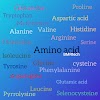Alanine | Introduction | History | Structure | Function.....
ALANINE AMINO ACID
Alanine (symbol Ala or A) is an α-amino acid that is used in the biosynthesis of proteins.
Or
Alanine is a non-essential amino acid that occurs in high levels in its free state in plasma.
It is produced from pyruvate by transamination. It is involved in sugar and acid metabolism, increases immunity, and provides energy for muscle tissue, brain, and the central nervous system. It contains an amine group and a carboxylic acid group, both attached to the central carbon atom which also carries a methyl group side chain. Consequently, its IUPAC systematic name is 2-aminopropanoic acid, and it is classified as a nonpolar, aliphatic α-amino acid. It is non-essential to humans as it can be synthesised metabolically and does not need to be present in the diet. It is encoded by all codons starting with GC (GCU, GCC, GCA, and GCG).
The L-isomer of alanine (left-handed) is the one that is incorporated into proteins. L-Alanine is second only to leucine in rate of occurrence, accounting for 7.8% of the primary structure in a sample of 1,150 proteins. The right-handed form, D-alanine, occurs in polypeptides in some bacterial cell walls and in some peptide antibiotics, and occurs in the tissues of many crustaceans and molluscs as an osmolyte.
Properties :-
Chemical formula :- C3H7NO2
Molar mass :- 89.094 g.mg-1
Appearance :- white powder
Density :- 1.424 g/cm3
Melting point :- 258 °C (496 °F; 531 K) (sublimes)
Acidity (pKa) :- 2.34 (carboxyl; H2O), 9.87 (amino; H2O)
Thermodynamic data :- Phase behaviour (solid–liquid–gas)
HISTORY :-
Alanine was first synthesized in 1850 when Adolph Strecker combined acetaldehyde and ammonia with hydrogen cyanide. The amino acid was named Alanin in German, in reference to aldehyde, with the infix -an- for ease of pronunciation, the German ending -in used in chemical compounds being analogous to English -ine.
SOURCES :-
Biosynthesis - Alanine can be synthesized from pyruvate and branched chain amino acids such as valine, leucine, and isoleucine. Alanine is produced by reductive amination of pyruvate, a two-step process. In the first step, α-ketoglutarate, ammonia and NADH are converted by glutamate dehydrogenase to glutamate, NAD+ and water. In the second step, the amino group of the newly-formed glutamate is transferred to pyruvate by an aminotransferase enzyme, regenerating the α-ketoglutarate, and converting the pyruvate to alanine. The net result is that pyruvate and ammonia are converted to alanine, consuming one reducing equivalent. It can be formed by metabolic pathways such as glycolysis, gluconeogenesis, and the citric acid cycle.
Chemical Synthesis - L-Alanine is produced industrially by decarboxylation of L-aspartate by the action of aspartate 4-decarboxylase. Fermentation routes to L-alanine are complicated by alanine racemase. Racemic alanine can be prepared by the condensation of acetaldehyde with ammonium chloride in the presence of sodium cyanide by the Strecker reaction, or by the ammonolysis of 2-bromopropanoic acid.
Degradation - Alanine is broken down by oxidative deamination, the inverse reaction of the reductive amination reaction described above, catalyzed by the same enzymes. The direction of the process is largely controlled by the relative concentration of the substrates and products of the reactions involved.
SUBSCRIBE FOR MORE INFORMATION........!








0 Comments